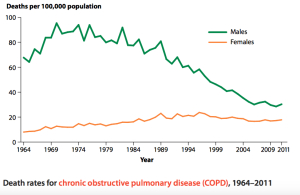The nature of the problem
Respiratory diseases include: chronic obstructive pulmonary disease (COPD – which includes emphysema and chronic bronchitis), and asthma.
COPD are diseases that destroy lung tissue and result in a narrowing of the airways, limiting oxygen uptake. People with COPD often wheeze and are chronically short of breath. It is causes by long term exposure to air pollutants such as smoke.
Asthma is an inflammatory disease of the airways. For most forms of asthma there is a trigger that sets off the inflammatory response in the airways, which produces a large enough reaction to narrow the airways and limit oxygen uptake. Asthma can range from mild symptoms to life threatening attacks. During major asthma attacks, ariways narrow so far that there is not enough oxygen for the body to maintain function of its vital organs. If not treated speedily, major asthma attacks can cause brain damage and death. Inhalers normally manage asthma by either: preventing an attack from occurring or relieving the attack after it has begun. Asthma is Australia’s most widespread disease and affects people’s quality of life, causing many sick days from work and absence from school. It also can limit people’s choice to be involved in regular physical activity.
Extent of the problem (trends)
29% of Australian’s suffer from a chronic respiratory disease; hay fever and asthma are the most common diseases. Asthma is one of the most common chronic diseases amongst children, affecting 9%. The death rates for asthma have fallen from 6.6% to 1.5% over the last 20 years. Asthma is the most common chronic respiratory disease treated by GPs, though the hospitalisation rate has fallen by 38% in the last 20 years.
COPD has fallen in prevalence from 4% to 2% over the last 10 years. Chronic lower respiratory disease is the 5th highest cause of death in Australia and COPD is the 3rd highest burden of disease accounting for 3.5% of all disability adjusted life years.
In the last 40 years the death rate for COPD has fallen by more than 2/3 for males but there has been a small rise in the death rate for females. The rate of hospitalisation for COPD has also fallen for males over 55, though not for females. This most probably reflects the changes in smoking rates amongst males.
Risk factors and protective factors
Major risk factors for respiratory diseases include: family history, smoking, physical inactivity, certain viral infections and exposure to air pollutants.
Protective factors for respiratory disease include: not smoking, and regular physical activity.
The sociocultural, socioeconomic and environmental determinants
Sociocultural factors of respiratory disease include: family, peers, culture, media and religion. For respiratory diseases, family history of asthma increases the likelihood of being diagnosed with asthma. For COPD, people from at ATSI heritage are more likely to be diagnosed, mostly because of the higher rates of smoking amongst ATSI people.
The socioeconomic determinants of respiratory disease include: employment, education and income. People who have low socioeconomic status are more likely to be diagnosed with COPD because of their higher smoking rates. People with lower levels of education are more likely to make poor health choices. Some forms of employment expose people more frequently to air pollution, such as mining, and these people are also more likely to be diagnosed with respiratory diseases.
Environmental determinants of respiratory disease include geographic location and access to health services and technology. People in rural and remote areas have higher rates of mortality from asthma, because of their greater distance to emergency services. People who live close to air pollutants are more likely to be diagnosed with other respiratory diseases.
Groups at risk
The major groups of people at risk of respiratory diseases are: smokers, people whose employment has air pollutant exposure, the elderly (especially for COPD), people with low socioeconomic status, young children (for Asthma), ASTI, and rural and remote living people who have higher mortality rates for asthma.




